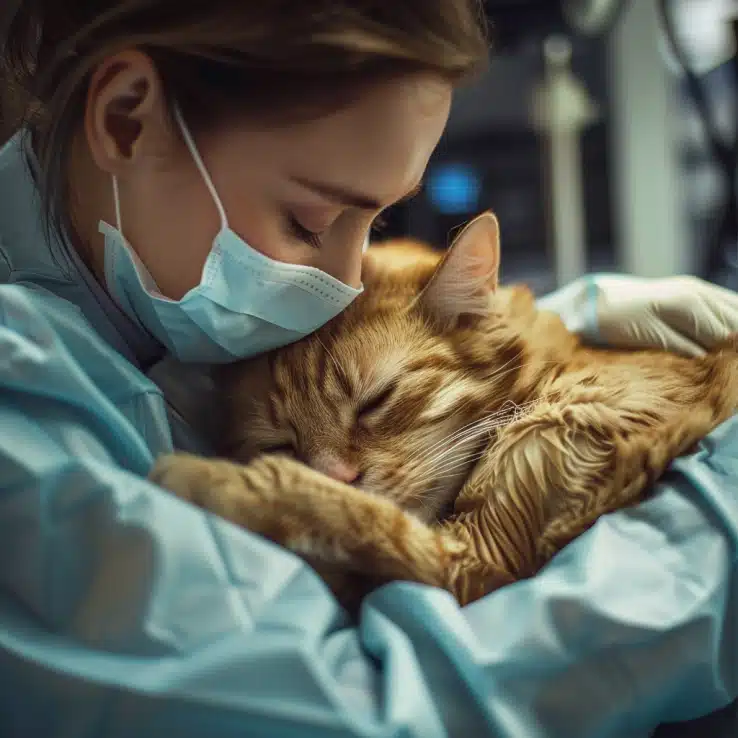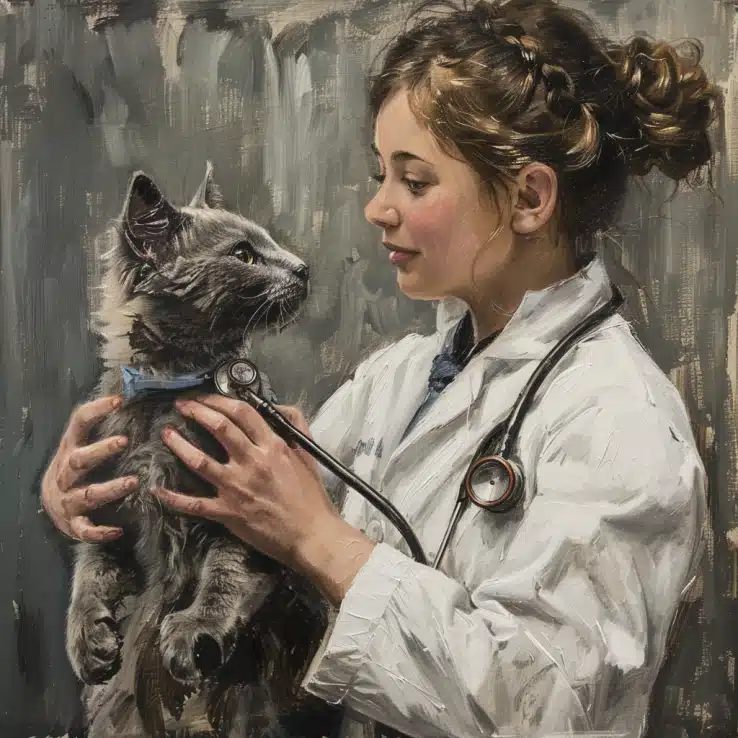TLDR: A study found that veterinarians frequently euthanizing animals have higher rates of serious suicidal thoughts and are more likely to support euthanasia for humans. Working with companion animals is associated with positive attitudes towards human euthanasia.
Highlights:
- Data from over 2,500 veterinarians in Norway.
- 55% of veterinarians support euthanasia for humans with terminal illness.
- Working with companion animals increases positive attitudes towards human euthanasia.
- Performing euthanasia 5+ times per week is linked to serious suicidal thoughts.
- High perceived colleague support reduces the likelihood of serious suicidal thoughts.
Source: BMC Psychiatry (2024)
Veterinarians, Euthanasia, Mental Health (Overview)
Veterinarians face unique challenges and stressors in their profession, particularly related to the frequent euthanasia of animals.
These tasks not only require technical skill and emotional strength but also present significant ethical dilemmas.
Previous studies have indicated that veterinarians have a higher suicide rate compared to the general population, suggesting that the demands of their job might be taking a toll on their mental health.
Why research this?
- High Suicide Risk: Veterinarians have been identified as an occupational group with a notably high suicide rate. The reasons for this increased risk are not fully understood, making it crucial to investigate all potential contributing factors, including the impact of euthanizing animals.
- Ethical & Emotional Burden: Euthanizing animals is a routine part of veterinary practice, especially in companion animal clinics. This task, while often viewed as a compassionate end-of-life care option, carries a significant emotional burden. Researching its effects on veterinarians’ mental health and ethical perspectives can help identify the support they need to manage these responsibilities.
- Attitudes Towards Human Euthanasia: The experience of performing animal euthanasia may shape veterinarians’ views on human euthanasia. This is important not only for understanding their professional and personal attitudes but also for broader discussions about euthanasia policies and practices in society. Veterinarians’ insights can provide valuable perspectives in these debates.
Key Findings: Veterinarians & Animal Euthanasia vs. (1) Assisted Dying Attitudes & (2) Suicidal Thoughts

1. Attitudes Towards Human Euthanasia
General Support: Over half of the veterinarians surveyed (55%) agreed that euthanasia should be permitted for humans suffering from a fatal disease with a short remaining life expectancy. This indicates a considerable level of support for human euthanasia among veterinarians, which aligns with the general population’s views in Norway.
Companion Animal Practice: Veterinarians working in companion animal practice were notably more likely to support human euthanasia. The odds ratio (OR) for this group was 1.66, meaning they had 66% higher odds of supporting human euthanasia compared to those working in mixed clinical practice. This suggests that the nature of their work, which often involves euthanizing pets perceived as family members, might influence their attitudes towards end-of-life decisions for humans.
Demographics: Younger veterinarians and those who were single showed higher levels of support for human euthanasia. These demographic factors were significantly associated with positive attitudes, indicating that personal life circumstances and generational perspectives might play a role in shaping views on euthanasia.
2. Frequency of Euthanasia & Serious Suicidal Thoughts
High Euthanasia Frequency: Veterinarians who reported performing euthanasia five or more times per week had a significantly higher likelihood of experiencing serious suicidal thoughts. The adjusted odds ratio for this group was 2.56, indicating more than twice the risk compared to those who euthanized animals less frequently. This finding highlights a critical mental health risk factor related to the frequent performance of euthanasia.
Colleague Support: The study found that low perceived support from colleagues was associated with a higher risk of serious suicidal thoughts. Veterinarians who felt unsupported by their colleagues had a greater likelihood of experiencing these thoughts, emphasizing the importance of a supportive work environment in mitigating mental health risks.
Single Status: Single veterinarians were also at an increased risk for serious suicidal thoughts, with an adjusted odds ratio of 2.11. This suggests that social isolation or lack of personal support networks outside of work might exacerbate the mental health challenges faced by veterinarians.
Positive Attitudes Towards Human Euthanasia: There was a notable association between having positive attitudes towards human euthanasia and experiencing serious suicidal thoughts. Veterinarians who supported human euthanasia were twice as likely to have serious suicidal thoughts (adjusted OR = 2.00). This relationship could reflect a broader perspective on suffering and end-of-life decisions impacting their own mental health.
Additional Findings:
- No Direct Link to Positive Attitudes: The frequency of performing euthanasia was not directly associated with positive attitudes towards human euthanasia. This suggests that while frequent euthanasia tasks increase mental health risks, they do not necessarily shape more positive views on human euthanasia.
- Field of Work: The main field of veterinary practice influenced attitudes towards euthanasia. Veterinarians in public administration, academia, and other non-clinical fields showed no significant difference in attitudes compared to those in mixed clinical practice, highlighting the unique experiences of companion animal veterinarians.
Tables of Key Results
Table 1: Attitudes Towards Human Euthanasia by Field of Work
| Field of Work | Adjusted OR | 95% CI | Significance |
|---|---|---|---|
| Companion Animal Practice | 1.66 | 1.23 – 2.23 | p < 0.05 |
| Production Animal Practice | 1.04 | 0.69 – 1.56 | Not Significant |
| Equine Practice | 1.29 | 0.80 – 2.09 | Not Significant |
| Aquaculture | 1.07 | 0.69 – 1.67 | Not Significant |
| Public Administration | 0.98 | 0.70 – 1.35 | Not Significant |
| Academia/Research | 1.35 | 0.92 – 1.98 | Not Significant |
| Other | 1.07 | 0.74 – 1.53 | Not Significant |
Table 2: Factors Associated with Serious Suicidal Thoughts
| Factor | Adjusted OR | 95% CI | Significance |
|---|---|---|---|
| Frequency of Euthanasia (5+ per week) | 2.56 | 1.35 – 4.87 | p < 0.05 |
| Single Status | 2.11 | 1.42 – 3.15 | p < 0.05 |
| Positive Attitudes Towards Human Euthanasia | 2.00 | 1.29 – 3.09 | p < 0.05 |
| Low Colleague Support | 0.63 | 0.56 – 0.72 | p < 0.05 |
NORVET Study (2024): Veterinarians & Mental Health vs. Euthanasia (Details)

The study evaluated the relationship between euthanizing animals, attitudes towards human euthanasia, and mental health – of veterinarians.
- Assessed veterinarians’ attitudes towards physician-assisted suicide and euthanasia in humans.
- Determined if the field of work and the frequency of euthanizing animals are associated with positive attitudes towards human euthanasia.
- Examined whether frequently euthanizing animals is associated with serious suicidal thoughts.
Method: The study employed a nationwide cross-sectional survey design, targeting all veterinarians in Norway holding valid authorization in May 2020. Key steps and methodologies included:
Sample: From the 4,256 veterinarians initially identified, exclusions were made for those without a residential address in Norway, unknown current address, working abroad, or deceased, resulting in an eligible sample of 3,464 participants.
Survey: A comprehensive 12-page questionnaire was distributed by mail, with follow-up reminders sent to ensure a high response rate. The survey included questions on demographics, work-related factors, attitudes towards euthanasia, and mental health.
Instruments:
- Attitudes Towards Euthanasia: Four statements assessing support for physician-assisted suicide and euthanasia in humans, using a Likert scale.
- Serious Suicidal Thoughts: Paykel’s questionnaire, specifically the item measuring serious suicidal thoughts and plans.
- Frequency of Euthanasia: A single item measuring the average number of euthanasia procedures performed weekly.
- Colleague Support: Assessed using two questions on enjoyment and perceived care from colleagues, scored on a 1 to 7 scale.
- Statistical Analysis: Logistic regression models were used to calculate odds ratios for positive attitudes towards euthanasia and serious suicidal thoughts, adjusting for confounders such as age, gender, marital status, working hours, and colleague support.
Results
Attitudes Towards Human Euthanasia
- 55% of veterinarians agreed that euthanasia should be permitted for humans with a terminal illness and short life expectancy.
- Veterinarians working with companion animals showed significantly higher odds (OR = 1.66) of supporting human euthanasia compared to those in mixed clinical practice.
- Positive attitudes towards euthanasia were more prevalent among younger and single veterinarians.
Frequency of Euthanizing Animals & Suicidal Thoughts
- Performing euthanasia five or more times per week was significantly associated with serious suicidal thoughts (OR = 2.56).
- Factors like being single, having positive attitudes towards human euthanasia, and low colleague support also increased the likelihood of serious suicidal thoughts.
Limitations:
- Cross-Sectional Design: The study’s cross-sectional nature limits the ability to infer causality. It can only suggest associations rather than definitive cause-and-effect relationships.
- Self-Report Bias: Data were collected through self-reported questionnaires, which may introduce recall bias or social desirability bias.
- Generalizability: While the response rate was high, the findings may primarily reflect the experiences of veterinarians in Norway and may not be directly generalizable to veterinarians in other countries with different cultural and professional contexts.
- Instrument Limitations: The dichotomization of responses for attitudes towards euthanasia and serious suicidal thoughts may have oversimplified complex attitudes and experiences.
- Potential Confounders: Although several confounders were controlled for, there may still be unmeasured variables affecting both the frequency of euthanasia and mental health outcomes.
Conclusion: Veterinarians & Mental Health vs. Euthanasia
This study sheds light on the significant mental health challenges faced by veterinarians, particularly those frequently involved in euthanasia procedures.
The findings reveal a clear link between the frequency of euthanasia tasks and increased suicidal thoughts, highlighting the need for targeted mental health support and workplace interventions.
By implementing supportive policies, comprehensive training, and robust peer networks, the veterinary profession can address these unique stressors and enhance the well-being of its members.
Overall, these measures not only safeguard the mental health of veterinarians but also contribute to a more compassionate and effective veterinary practice.
References
- Study: Euthanasia of animals – association with veterinarians’ suicidal thoughts and attitudes towards assisted dying in humans: a nationwide cross-sectional survey (the NORVET study) (2024)
- Authors: Helene Seljenes Dalum et al.







